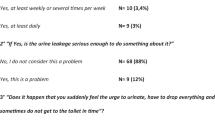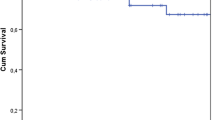Abstract
Introduction and hypothesis
We report retrospective data on the long-term safety and efficacy of the retropubic midurethral sling (MUS) in a large series of women with stress urinary incontinence.
Methods
In all, 517 patients were treated during the period January 2005 to June 2012 at a single centre in France. The Urinary Symptoms Profile score was used to identify women who were subjectively cured or improved or in whom treatment had failed. The rates of peroperative, and early (<30 days) and late postoperative complications were recorded.
Results
A total of 463 patients were evaluable at a mean (±SD) follow-up of 71 ± 23 months. At the last follow-up, 344 patients (74.3 %) demonstrated subjective cure, 55 (11.9 %) were improved and 64 (13.8 %) had treatment failure. Bladder perforations occurred in 33 patients (7.1 %); however, this had no effect on cure rate. In the early postoperative period, temporary intermittent self-catheterization was required in 10 patients (2.2 %) due to voiding difficulties. The most frequent long-term postoperative complication was de novo urge incontinence that was reported by 59 patients (12.7 %); seven patients (1.5 %) needed tape excision due to voiding difficulties and six (1.3 %) needed tape removal due to erosion or chronic pain.
Conclusions
The retropubic MUS was shown to be durable at a mean follow-up of 71 ± 23 months, with a high success/improvement rate and no serious long-term tape-induced adverse effects.
Similar content being viewed by others
References
Ulmsten U, Henriksson L, Johnson P, Varhos G. An ambulatory surgical procedure under local anesthesia for treatment of female urinary incontinence. Int Urogynecol J Pelvic Floor Dysfunct. 1996;7:81–6.
US Food and Drug Administration. Considerations about Surgical Mesh for SUI. Silver Spring, MD: US Food and Drug Administration; 2013. http://www.fda.gov/MedicalDevices/ProductsandMedicalProcedures/ImplantsandProsthetics/PUroGynSurgicalMesh/ucm345219.htm. Accessed 6 Dec 2016.
Petros PE, Ulmsten UI. An integral theory of female urinary incontinence. Experimental and clinical considerations. Acta Obstet Gynecol Scand Suppl. 1990;153:7–31.
Westby M, Asmussen M, Ulmsten U. Location of maximum intraurethral pressure related to urogenital diaphragm in the female subject as studied by simultaneous urethrocystometry and voiding urethrocystography. Am J Obstet Gynecol. 2009;144:408–412.
Kociszewski J, Rautenberg O, Kuszka A, Eberhard J, Hilgers R, Viereck V. Can we place tension-free vaginal tape where it should be? The one-third rule. Ultrasound Obstet Gynecol. 2012;39:210–4.
Bogusiewicz M, Monist M, Gałczyński K, Woźniak M, Wieczorek AP, Rechberger T. Both the middle and distal sections of the urethra may be regarded as optimal targets for ‘outside-in’ transobturator tape placement. World J Urol. 2014;32:1605–1611.
Schimpf MO, Rahn DD, Wheeler TL, Patel M, White AB, Orejuela FJ, et al. Sling surgery for stress urinary incontinence in women: a systematic review and meta-analysis. Am J Obstet Gynecol. 2014;211(1):71.e1–71.e27.
Brubaker L, Norton PA, Albo ME, Chai TC, Dandreo KJ, Lloyd KL, et al. Adverse events over two years after retropubic or transobturator midurethral sling surgery: findings from the Trial of Midurethral Slings (TOMUS) study. Am J Obstet Gynecol. 2011;205(5):498.e1–498.e6.
Haab F, Richard F, Amarenco G, Coloby P, Arnould B, Benmedjahed K, et al. Comprehensive evaluation of bladder and urethral dysfunction symptoms: development and psychometric validation of the urinary symptom profile (USP) Questionnaire. Urology. 2008;71:646–656.
Schäfer W, Abrams P, Liao L, Mattiasson A, Pesce F, Spangberg A, et al. Good urodynamic practices: uroflowmetry, filling cystometry, and pressure-flow studies. Neurourol Urodyn. 2002;21:261–274.
Ulmsten U, Falconer C, Johnson P, Jomaa M, Lannér L, Nilsson CG, et al. A multicenter study of tension-free vaginal tape (TVT) for surgical treatment of stress urinary incontinence. Int Urogynecol J Pelvic Floor Dysfunct. 1998;9:210–213.
Barber MD, Kleeman S, Karram MM, Paraiso M, Walters M, Vasavada S, et al. Transobturator tape compared with tension-free vaginal tape for the treatment of stress urinary incontinence. Obstet Gynecol. 2008;111:611–621.
Bai SW, Sohn WH, Chung DJ, Park JH, Kim SK. Comparison of the efficacy of Burch colposuspension, pubovaginal sling, and tension-free vaginal tape for stress urinary incontinence. Int J Gynaecol Obstet. 2005;91:246–251.
Wang F, Song Y, Huang H. Prospective randomized trial of TVT and TOT as primary treatment for female stress urinary incontinence with or without pelvic organ prolapse in Southeast China. Arch Gynecol Obstet. 2010;281:279–286.
Rinne K, Laurikainen E, Kivelä A, Aukee P, Takala T, Valpas A, et al. A randomized trial comparing TVT with TVT-O: 12-month results. Int Urogynecol J Pelvic Floor Dysfunct. 2008;19:1049–1054.
El-Hefnawy AS, Wadie BS, El Mekresh M, Nabeeh A, Bazeed MA. TOT for treatment of stress urinary incontinence: how should we assess its equivalence with TVT? Int Urogynecol J. 2010;21:947–953.
Richter HE, Albo ME, Zyczynski HM, Kenton KK, Norotn PA, Sirls LT, et al. Retropubic versus transobturator midurethral slings for stress incontinence. N Engl J Med. 2010;362:2066–2076.
Nilsson CG, Palva K, Aarnio R, Morcos E, Falconer C. Seventeen years’ follow-up of the tension-free vaginal tape procedure for female stress urinary incontinence. Int Urogynecol J. 2013;24:1265–1269.
Celebi I, Güngördük K, Ark C, Akyol A. Results of the tension-free vaginal tape procedure for treatment of female stress urinary incontinence: a 5-year follow-up study. Arch Gynecol Obstet. 2009;279:463–467.
Ford AA, Rogerson L, Cody JD, Ogah J. Mid-urethral sling operations for stress urinary incontinence in women. Cochrane Database Syst Rev. 2015;(7), CD006375.
Bakali E, Buckley BS, Hilton P, Tincello DG. Treatment of recurrent stress urinary incontinence after failed minimally invasive synthetic suburethral tape surgery in women. Cochrane Database Syst Rev. 2013;(2), CD009407.
Ford AA, Ogah JA. Retropubic or transobturator mid-urethral slings for intrinsic sphincter deficiency-related stress urinary incontinence in women: a systematic review and meta-analysis. Int Urogynecol J. 2016;27:19–28.
Novara G, Galfano A, Boscolo-Berto R, Secco S, Cavalleri S, Ficarra V, et al. Complication rates of tension-free midurethral slings in the treatment of female stress urinary incontinence: a systematic review and meta-analysis of randomized controlled trials comparing tension-free midurethral tapes to other surgical procedures and different devices. Eur Urol. 2008;53:288–308.
Walters MD, Tulikangas PK, LaSala C, Muir TW. Vascular injury during tension-free vaginal tape procedure for stress urinary incontinence. Obstet Gynecol. 2001;98:957–959.
Wang YJ, Li FP, Wang Q, Yang S, Cai X, Chen Y. Comparison of three mid-urethral tension-free tapes (TVT, TVT-O, and TVT-Secur) in the treatment of female stress urinary incontinence: 1-year follow-up. Int Urogynecol J. 2011;22:1369–1374.
Doo CK, Hong B, Chung BJ, Kim JY, Jung HC, Lee K-S, et al. Five-year outcomes of the tension-free vaginal tape procedure for treatment of female stress urinary incontinence. Eur Urol. 2006;50:333–338.
Song PH, Kim YD, Kim HT, Lim HS, Hyun CH, Seo JH, et al. The 7-year outcome of the tension-free vaginal tape procedure for treating female stress urinary incontinence. BJU Int. 2009;104:1113–1117.
Nilsson CG, Kuuva N, Falconer C, Rezapour M, Ulmsten U. Long-term results of the tension-free vaginal tape (TVT) procedure for surgical treatment of female stress urinary incontinence. Int Urogynecol J. 2001;12:S5–S8.
Serati M, Ghezzi F, Cattoni E, Braga A, Siesto G, Torella M, et al. Tension-free vaginal tape for the treatment of urodynamic stress incontinence: efficacy and adverse effects at 10-year follow-up. Eur Urol. 2012;61:939–946.
Acknowledgements
Editorial support was provided by Medscimedia Ltd and funded by Boston Scientific Corporation.
Author information
Authors and Affiliations
Corresponding author
Ethics declarations
Funding
None.
Conflicts of interest
B. Fatton: Payment received for honoraria, research and consultancy from Boston Scientific and AMS; payment received for consultancy from Allergan and Astellas.
R. de Tayrac: Payment received for honoraria, research and consultancy from Boston Scientific.
P. Costa: Payment received for honoraria, research and consultancy from Boston Scientific.
All other authors declare no conflicts of interest.
Rights and permissions
About this article
Cite this article
Chevrot, A., Droupy, S., Coffin, G. et al. Long-term efficacy and safety of tension free vaginal tape in a historic cohort of 463 women with stress urinary incontinence. Int Urogynecol J 28, 827–833 (2017). https://doi.org/10.1007/s00192-016-3230-2
Received:
Accepted:
Published:
Issue Date:
DOI: https://doi.org/10.1007/s00192-016-3230-2




